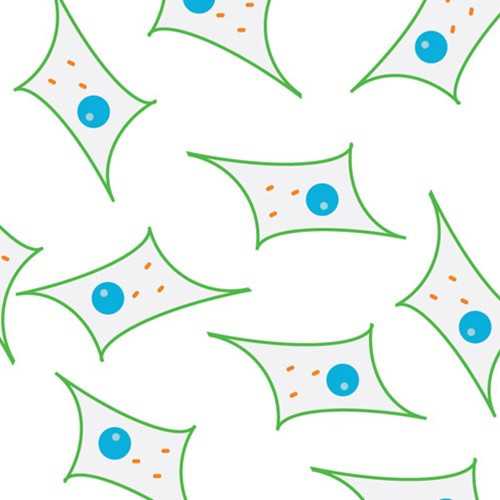Human Renal Proximal Tubule Epithelial (TH1) Cell Line
The TH1 cells are derived from primary human renal proximal tubule epithelial cells (RPTECs) immortalized by two lentiviral vectors carrying the human telomerase (hTERT) and the SV40 T antigen (Tag).
These cells can sustain long-term proliferation in culture, exhibit contact-inhibited, anchorage- and growth factor-dependent growth and do not form tumors in nude mice. TH1 cells express alkaline phosphatase and gamma-glutamyltranspeptidase, two brush-border enzymes expressed in RPTECs. TH1 cells also perform critical metabolic activities characteristic of renal proximal tubule cells, including active glucose transport and ammonia production and excretion.
Both the hTERT and Tag genes in the lentiviral vectors are flanked by loxP sites. Transient Cre expression in TH1 cells leads to efficient proviral deletion and upregulation of some renal specific activities. Removal of the genes for cell immortalization also significantly decreases the rate of cell proliferation and ultimately leads to cell senescence, suggesting that the cell cycle control remains intact in TH1 cells despite continuous passage of these cells in culture.
From the laboratory of Jiing-Kuan Yee, PhD, City of Hope.
 Part of The Investigator's Annexe program.
Part of The Investigator's Annexe program.
The TH1 cells are derived from primary human renal proximal tubule epithelial cells (RPTECs) immortalized by two lentiviral vectors carrying the human telomerase (hTERT) and the SV40 T antigen (Tag).
These cells can sustain long-term proliferation in culture, exhibit contact-inhibited, anchorage- and growth factor-dependent growth and do not form tumors in nude mice. TH1 cells express alkaline phosphatase and gamma-glutamyltranspeptidase, two brush-border enzymes expressed in RPTECs. TH1 cells also perform critical metabolic activities characteristic of renal proximal tubule cells, including active glucose transport and ammonia production and excretion.
Both the hTERT and Tag genes in the lentiviral vectors are flanked by loxP sites. Transient Cre expression in TH1 cells leads to efficient proviral deletion and upregulation of some renal specific activities. Removal of the genes for cell immortalization also significantly decreases the rate of cell proliferation and ultimately leads to cell senescence, suggesting that the cell cycle control remains intact in TH1 cells despite continuous passage of these cells in culture.
From the laboratory of Jiing-Kuan Yee, PhD, City of Hope.
 Part of The Investigator's Annexe program.
Part of The Investigator's Annexe program.
| Product Type: | Cell Line |
| Name: | TH1 |
| Cell Type: | Proximal tubule epithelial cells |
| Accession ID: | CVCL_5J51 |
| Source: | Human kidney |
| Organism: | Human |
| Morphology: | Cobblestone-like morphology |
| Biosafety Level: | BSL-2 |
| Growth Conditions: | DMEM-HIGH Glucose (HyClone # SH30022.01) and 10% FBS (HyClone # SV30014.03) |
| Subculturing: | 1 to 5 dilution every 5 days |
| Cryopreservation: | DMEM + 20% FBS + 10% DMSO |
| Storage: | -150C |
| Shipped: | Dry ice |
TH1 Cell morphology.

(a) Primary RPTECs at passage 7. (b) Primary RPTECs at passage 7 stained for senescence-specific b-Gal expression. (c) TH1 cells at passage 30. (d) Immunofluorescent staining of cells in (c) for cytokeratin. (e) Cell proliferation assay. BrdU incorporation was measured in proliferating and confluent TH1 cells. The results were normalized to the cell number.
Adapted from: Kowolik CM, Liang S, Yu Y & Yee JK. Cre-mediated reversible immortalization of human renal proximal tubular epithelial cells. Oncogene, 23:5950-5957, (2004).
- Kowolik CM, Liang S, Yu Y & Yee JK. Cre-mediated reversible immortalization of human renal proximal tubular epithelial cells. Oncogene, 23:5950-5957, (2004).
- Bicalho MD, Soares DB, Botoni FA, Reis AM, Martins MA. Drug-Induced Nephrotoxicity and Dose Adjustment Recommendations: Agreement Among Four Drug Information Sources. Int J Environ Res Public Health. 2015;12(9):11227–11240. Published 2015 Sep 9. View Article
- Sharpe CC, Dockrell ME. Primary culture of human renal proximal tubule epithelial cells and interstitial fibroblasts. Methods Mol Biol. 2012;806:175-85. doi: 10.1007/978-1-61779-367-7_12. View Article
- Maliszewska-Olejniczak K, Brodaczewska KK, Bielecka ZF, Czarnecka AM. Three-Dimensional Cell Culture Model Utilization in Renal Carcinoma Cancer Stem Cell Research. Methods Mol Biol. 2018;1817:47-66. View Article
- Han YS, Yoon YM, Go G, Lee JH, Lee SH. Melatonin Protects Human Renal Proximal Tubule Epithelial Cells Against High Glucose-Mediated Fibrosis via the Cellular Prion Protein-TGF-β-Smad Signaling Axis. Int J Med Sci. 2020;17(9):1235-1245. Published 2020 May 18. View Article
- Yoon YM, Go G, Yun CW, Lim JH, Lee SH. Knockdown of CK2α reduces P-cresol-induced fibrosis in human renal proximal tubule epithelial cells via the downregulation of profilin-1. Int J Med Sci. 2020 Oct 16;17(17):2850-2860. View Article
- Hricovíniová J, Hricovíniová Z, Kozics K. Antioxidant, Cytotoxic, Genotoxic, and DNA-Protective Potential of 2,3-Substituted Quinazolinones: Structure-Activity Relationship Study. Int J Mol Sci. 2021 Jan 9;22(2):610. View article
- Kohl Y, Biehl M, Spring S, Hesler M, Ogourtsov V, Todorovic M, Owen J, Elje E, Kopecka K, Moriones OH, Bastús NG, Simon P, Dubaj T, Rundén-Pran E, Puntes V, William N, von Briesen H, Wagner S, Kapur N, Mariussen E, Nelson A, Gabelova A, Dusinska M, Velten T, Knoll T. Microfluidic In Vitro Platform for (Nano)Safety and (Nano)Drug Efficiency Screening. Small. 2021 Jan 18:e2006012. View article
If you publish research with this product, please let us know so we can cite your paper.


